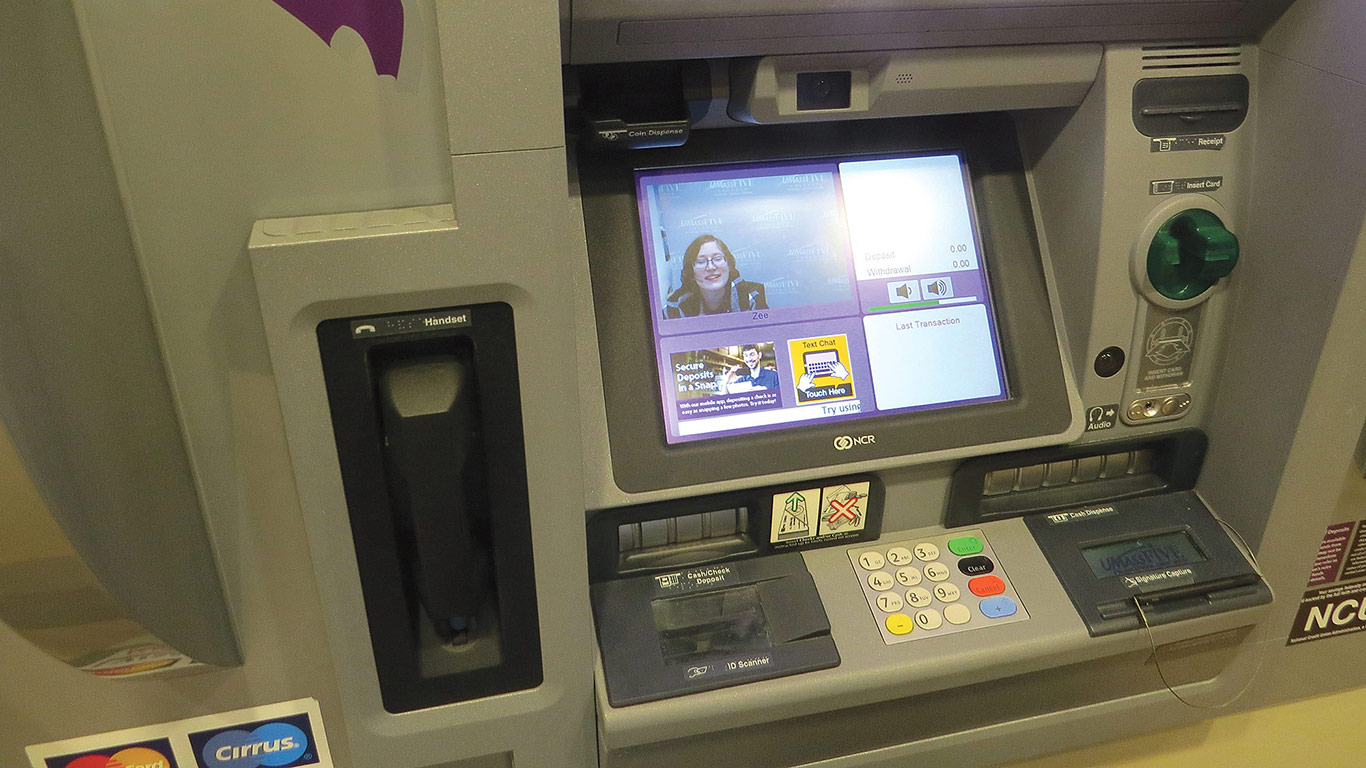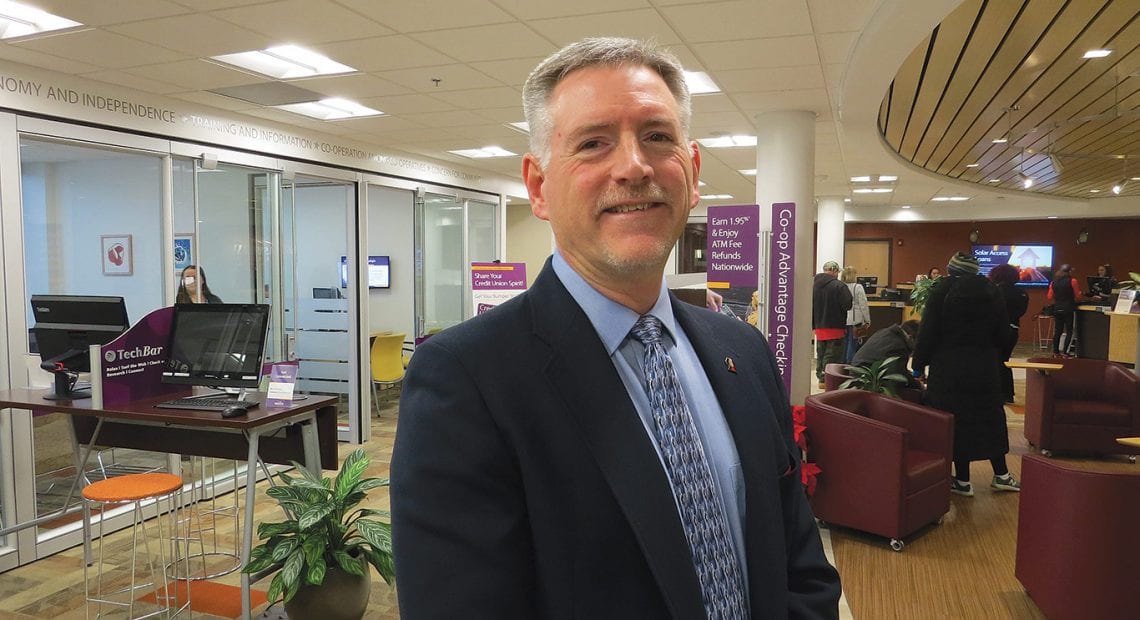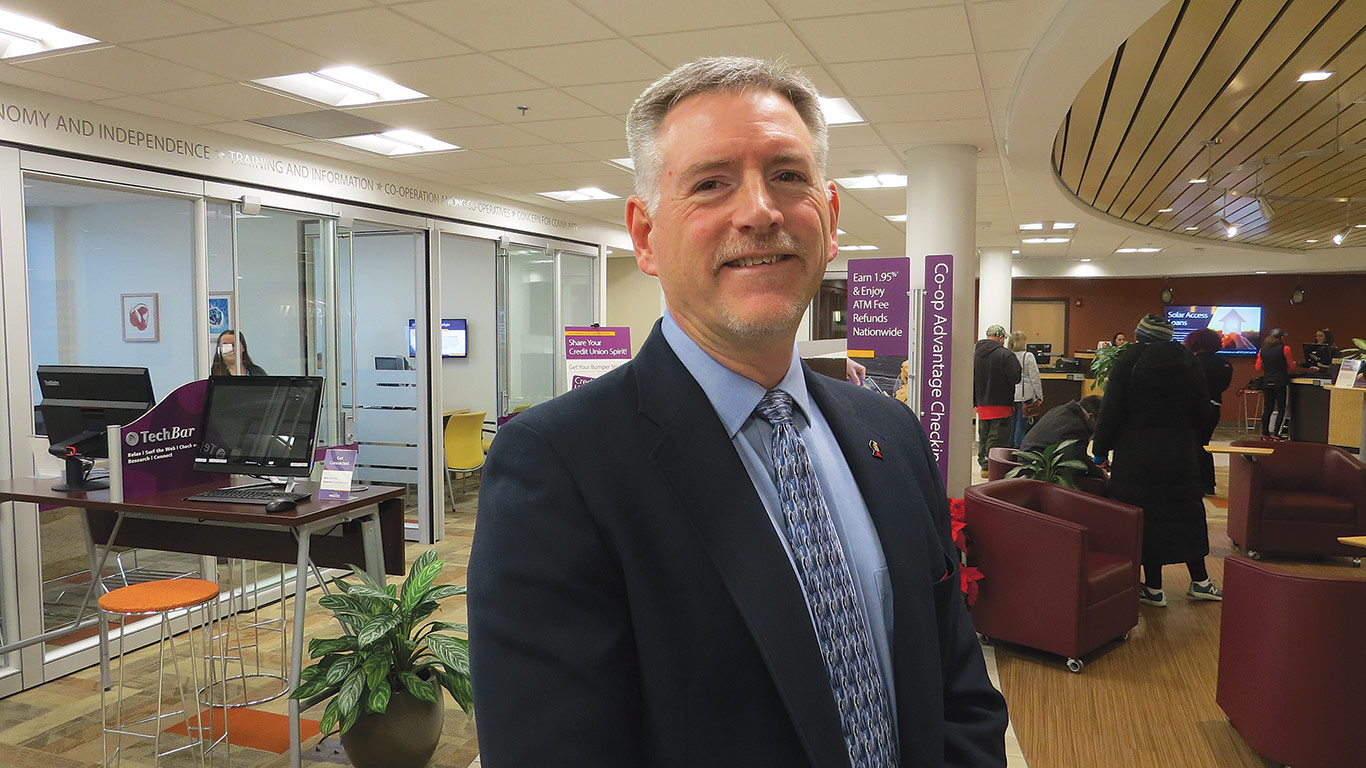Developments of Interest
As the name suggests, the UMassFive College Credit Union was launched to serve employees at UMass Amherst. But it quickly expanded its mission to the other schools in that region, and then beyond employees of those institutions. Today, the process of expansion and evolution continues, and touches many realms, from new branches to new technology to new member sponsors. In short, those humble beginnings have been left well behind.
Richard Kump has spent his entire career in financial services working for credit unions. That includes a lengthy stint at St. Mary’s Bank in Manchester, N.H.
This line on a résumé leads to a story he likes to tell and has told quite often.
“St. Mary’s was chartered in 1909; it was the first credit union in the country, but they didn’t call them credit unions then,” Kump explained. “It was built out of the French Canadian Catholic parish in the west side of Manchester serving the mill workers. They’ve held onto that ‘bank’ moniker without actually being one. It’s a bit of an identity crisis.
“The one bank in town was owned by the mill owners,” he went on. “They had practiced discrimination; if you were a French Canadian mill worker, you couldn’t get a mortgage from them, because they wanted you on their housing plan, which put you right next to the factory in terrible conditions. And that’s why the credit union was created — so those mill workers could pool their nickels and dimes and lend to each other so they could buy homes.”
While Kump likes relating the story of St. Mary’s, he quickly moved on to one he likes telling even more — the one concerning the institution he now leads as president and CEO — UMassFive College Credit Union, or UMassFive, as it’s known. And it’s a compelling story.
Founded in 1967 to serve employees at UMass Amherst, as the name suggests, it has moved well beyond its somewhat humble beginnings. In all kinds of ways.
Starting with the membership. Indeed, while the credit union still serves UMass employees, and those of the other institutions that make up the Five Colleges — Amherst, Hampshire, Smith, and Mount Holyoke colleges — it also serves their current students and alumni. Membership also extends to UMass Medical School in Worcester, where there is a non-traditional branch, and, most recently, Greenfield Community College.
And UMassFive has extended its reach far beyond what might be called academia, through both acquisition and the addition of several new ‘sponsors,’ as they’re called, including CISA (Community Involved in Sustaining Agriculture), River Valley Co-op, several area communities, and Mercy Medical Center in Springfield, where there is another non-traditional branch.
There are five branches in all, serving more than 43,000 members, said Kump, who became CEO last July. Meanwhile, assets, which totaled roughly $135 million when he arrived in 2000 to serve UMassFive as chief operating officer, are now approaching a half-billion; the institution expects to crash through that barrier this year.
Beyond these various forms of growth, a pattern mirrored by many credit unions over the past 20 years or so, UMassFive has changed in other ways, especially with regard to technology, said Kump, who likes to believe his institution is on the proverbial cutting edge in this realm.
As an example, he pointed to the ITM, or interactive teller machine, in the lobby of the main office just off Route 9 in Hadley. The ITMs, which are becoming increasingly prominent in other markets and are just starting to make their mark in this one, essentially replace ATMs. Customers can use one to talk to a real person (hence the name), conduct a wide range of transactions, and get answers to questions.
“This was a time when many financial institutions were burying their heads in the sand and trying to ride out the recession. Instead, we got very aggressive. We took advantage of those times, and it put us on a very firm setting.”
Beyond the ITMs, the UMassFive lobby is distinct because there are no tellers, at least in the traditional sense, said Kump, adding that each location now has banking specialists who take on what he called the ‘universal agent model.’
These individuals can assist customers with a broad range of banking needs, he went on, adding that this requires additional training and higher compensation than traditional tellers, but these are steps UMassFive is taking to better serve customers in these changing, more technology-driven times.
“What we’ve focused on is a marriage of high touch with high tech,” he explained. “We want to be able to provide the convenience of doing everything at your fingertips; at the same time, a lot of folks need help getting that done, so we want to make sure we have the staff who can help someone who is not tech-savvy.”
Meanwhile, another form of growth has been expansion into commercial products and services and development of a unique and now quite strong niche — the financing of residential solar-energy projects (much more on that later).
And while the present tense is intriguing, when it comes to the UMassFive story, there are some new chapters soon to be written, including a new branch in Greenfield, slated to open later this year, and perhaps some additional acquisitions at a time when they are continuing to dominate the landscape with regard to both banks and credit unions.
For this issue and its focus on banking and financial services, BusinessWest talked at length with Kump about how UMassFive continues to build upon its strong foundation and grow its footprint, in every sense of that term.
Dollars and Sense
When Kump arrived at UMassFive in late 2000 after a stint at Cathedral Credit Union in Manchester, the institution was operating out of cramped quarters in a building next to the Hangar restaurant on University Drive in Amherst.
How cramped?
“My office was a supply closet — literally,” he recalled. “Because the roofs were pitched, to get to my desk I had to bend over to go around to the back of my desk.”
The inconvenience was rather easy to tolerate, he went on, because the institution was building its new home in Hadley at the time, and thus those crawls were to be a temporary nuisance.
The new facility would be the first of many positive developments in this century, one that has proven to be a good one for credit unions — at least those with the size, determination, and imagination to cope with many forms of change, from a host of new regulations to rapidly advancing technology.
As he quickly rehashed his own tenure at UMassFive, as well as that of his predecessor, Kathy Hutchinson, who served the institution for more than four decades, Kump said UMassFive, and all credit unions, for that matter, greatly benefited from both the Great Recession of a decade ago and the ongoing consolidation of the banking industry.

The ITMs installed by UMassFive allow customers to see, and interact with, an employee of the credit union.
Elaborating, he noted that, as the recession was escalating and the stock market was collapsing, individuals were looking for a safe place to park their money. And many found one in the local credit union.
“During the early part of the recession, we saw unparalleled growth; we had three consecutive years of double-digit asset growth, including one year with more than 20% growth,” he recalled. “There was a lot of money coming out of the market, and it needed go somewhere safe. Meawhile, there was a lot of national bank disenfranchisement — there were ‘close-your-bank-account’ days and people protesting in front of Bank of America.
“This was a time when many financial institutions were burying their heads in the sand and trying to ride out the recession,” he went on. “Instead, we got very aggressive. We took advantage of those times, and it put us on a very firm setting.”
While this was going on, UMassFive, which has what’s known as a multi-sponsor charter (instead of a single sponsor or employer), as opposed to the more common community charter, was also taking on new sponsors, such as CISA and River Valley Co-op, that have brought many new members — and opportunities — to the institution.
“Some of the sponsors we’ve taken on recently have really been formative to our plans,” he explained. “We’ve found more members through our relationship with CISA than we have through the University of Massachusetts over the last couple of years. That’s because people who can’t join the credit union any other way join CISA, and then they’re eligible for UMassFive.”
While growing membership, the credit union has also recently been expanding its portfolio of products and services, especially on the commercial side of the ledger, specializing in loans for equipment and commercial real estate. The move was a synergistic one, said Kump, noting that many members own businesses or commercial real estate, specifically multi-family housing, and it has created many new opportunities to grow the institution.
“It was symbiotic — we felt we could help our members who had those commercial needs with a level of service we felt could compete very favorably, especially with some of the larger regional and national financial institutions,” he explained. “And at the same time, it develops a wonderful asset for the credit union.”
By All Accounts
Echoing business owners and managers across virtually all sectors, Kump said the pace of change is too great, and the number of potential disruptors on the horizon way too high, for institutions like his to write a traditional five-year plan.
Three years is about the outside for any strategic plan these days, he went on, adding that the latest such document crafted by those at UMassFive doesn’t contain any real secrets — simply ongoing expansion of current initiatives and a focus on continued, sustainable growth, because in the financial-services sector today, size — for banks and credit unions alike — really does matter because of the economies of scale it provides.
The Greenfield branch, a traditional facility, like the one the institution operates in downtown Northampton, will be perhaps the most visible — and costly —avenue of growth, he said, adding that expansion into that Franklin County community is a natural progression for UMassFive and a vehicle for better serving customers such as those at GCC and those in or related to the agriculture sector sponsored by CISA.
“This move has been in the planning stages for some time,” he said, adding that, in recent years, the credit union has been focused on other infrastructure initiatives, such as renovation of both the main office and the Northampton branch. “Now, it’s a matter of looking outward a little bit more.”
This new branch will be like the others the institution operates, he said, referring to the leading of edge of technology.
“We don’t build cookie-cutter branches; we’ve gone through branch metamorphosis the past few years,” he said, referring not only to the ITMs — which are now in drive-throughs as well as branch lobbies — but the personnel staffing these branches.
“We eliminated all tellers more than two years ago, because fewer and fewer of the transactions are coming to the branches,” he explained. “People are using mobile, they’re using online banking … they don’t have a need to come to the branch. But when they do come to the branch, it’s for something important.”
Which brings him back to that ‘universal agent,’ a phrase he uses, although he admits he’d like some better terminology.
“We’ve created a position where the individual has the knowledge that a branch manager would have in years past,” he explained. “They can help someone regardless of what they’re looking for.
“To make all this work, our hiring practices are much different,” he went on. “More of our hires have no banking experience than have banking experience, and what we’ve found works very well for us is that we hire people who are outgoing and care — they just want to help someone else.”
With the changes in technology and hiring strategy has also come a deeper commitment to training, a necessity if the machines and the people are going to properly serve the members, he continued.
“We’ve tripled our professional-development budget over the past three years,” said Kump. “And that’s because we’ve put a big onus on the employee in the branches; they have to know so much. They’re not the specialist anymore.”
Meanwhile, the institution will continue efforts to expand on the commercial side of the ledger and the solar-lending realm as well, he said, adding that UMassFive has already created quite a niche with such transactions.
“In three years, we’ve become the highest-volume residential solar lender in the Commonwealth,” he noted, adding that UMassFive has written more than $45 million in loans covering roughly 1,400 residential, and now commercial, solar projects.
And they’re being written for members across the state, he said, adding that solar installers are recommending the institution to people well outside the 413, many of whom have become members through membership in CISA.
Past Is Prologue
Returning to Manchester, N.H. and the credit union called St. Mary’s Bank, Kump said it was formed 110 years ago to serve the underserved.
“Hopefully, there’s still a lot of that left in that industry,” he said, adding that there’s quite a bit of it at UMassFive.
The institution’s unofficial slogan, put into use by Hutchinson, is “every member, every day.” That’s where its focus is and where it will stay, Kump said, even as it keeps adjusting proactively to new challenges and constant change.
George O’Brien can be reached at [email protected]






